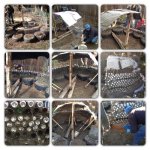well water. shallow hand dug 40ft.
How many ACT's are we talking about?
Assuming you know that ACT is not a fertilizer,
ACT could possibly consume as much food as they can actually get at in your soil if over applied...then they'll be fertilizer.
Perhaps you have a lack of humic material........and/or a lack of drainage amendments,which would cause anaerobic soil conditions..creating lockout.
A properly assembled soil will be able to handle an application of any logically mixed liquid organic fert with a ph of 4.0 one day....and the very next day be able to take a kelp tea with a ph of 9.0...no problem...plants don't even blink.
I use Protekt on every watering...I haven't ph'd a thing in 3 years in the same soil...I do not have issues.
A lot of the problems people face with building organic water only recyclable soil mixes is that the products offered as far as EWC and compost are shoddy and lacking in humic material...this is the most important aspect of any organic soil.
Check the quality of your compost or EWC.




